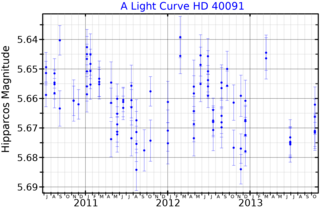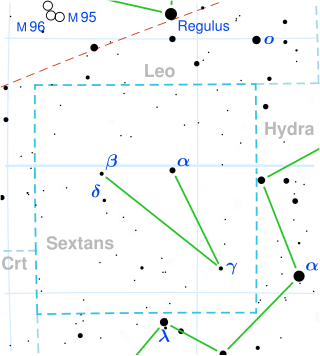R Apodis is a solitary star in the constellation Apus. It is faintly visible to the naked eye as an orange-hued point of light with an apparent magnitude of 5.36. Gaia DR3 parallax measurements imply a distance of 413 light-years and it is drifting closer with a heliocentric radial velocity of −31.2 km/s. At its current distance, R Apodis' brightness is diminished by an interstellar extinction of 0.26 magnitudes and it has an absolute magnitude of −0.22.

NO Apodis is a solitary, red hued variable star located in the southern circumpolar constellation Apus. It has an average apparent magnitude of 5.86, allowing it to be faintly seen with the naked eye. The object is relatively far at a distance of 790 light years but is drifting closer with a heliocentric radial velocity −18.3 km/s.

HD 27245, also known as HR 1335 or rarely 25 H. Camelopardalis is a solitary red-hued star located in the northern circumpolar constellation Camelopardalis. It has an apparent magnitude of 5.4, making it faintly visible to the naked eye. Gaia DR3 Parallax measurements place it approximately 607 light years away from it the Solar System and is drifting further away with a heliocentric radial velocity of 25.2 km/s. At its current distance, HD 27245's brightness is diminished by 0.36 magnitudes due to extinction from interstellar dust. It has an absolute magnitude of −0.27.
HD 63399 is an orange hued star located in the southern constellation Puppis, the poop deck. It has an apparent magnitude of 6.45, placing it near the limit for naked eye visibility. Based on parallax measurements from Gaia DR3, the object is estimated to be 445 light years distant. It appears to be receding with a spectroscopic radial velocity of 28.5 km/s. At its current distance, HD 63399 is diminished by 0.29 magnitudes due to interstellar dust.

S Apodis, also known as HD 133444 is a variable star located in the southern circumpolar constellation Apus. It has an apparent magnitude ranging from 9.6 to 17, which is below the limit for naked eye visibility. The object is located relatively far at a distance of approximately 15,000 light years based on Gaia DR3 parallax measurements, but it is drifting closer with a heliocentric radial velocity of −75 km/s.

HD 57197, also known as M Puppis or HR 2789, is a suspected astrometric binary located in the southern constellation Puppis, the poop deck. It has an apparent magnitude of 5.84, making it faintly visible to the naked eye under ideal conditions. Based on parallax measurements from the Gaia satellite, the system is estimated to be 629 light years away from the Solar System. The value is poorly constrained, but it appears to be receding with a heliocentric radial velocity of 13 km/s. At its current distance, HD 57197's brightness is diminished by 0.3 magnitudes due to interstellar dust. It has an absolute magnitude of -0.43.

HD 174387 is a solitary star in the southern constellation Telescopium. With an apparent magnitude of 5.49, it is faintly visible to the naked eye if viewed under dark skies. Parallax measurements put the object at a distance of 810 light years and it is currently approaching the Solar System with a heliocentric radial velocity of −28.1 km/s.
HD 1032 is a solitary star in the southern circumpolar constellation Octans. It is faintly visible to the naked eye with an apparent magnitude of 5.77 and is estimated to be 850 light years away from the Solar System based on parallax measure. However, it is receding with a heliocentric radial velocity of 4 km/s.
HD 194612 is a solitary orange hued star located in the southern circumpolar constellation Octans. It has an apparent magnitude of 5.9, making it visible to the naked eye under ideal conditions. Parallax measurements place it at a distance of 760 light years and it has a low heliocentric radial velocity of 0.3 km/s.
HD 37289, also known as HR 1916, is a solitary, orange hued star located in the northern circumpolar constellation Camelopardalis. It has an apparent magnitude of 5.61, making it faintly visible to the naked eye under ideal conditions. Based on parallax measurements from the Gaia spacecraft, the object is estimated to be 308 light years distant. It appears to be approaching the Sun, having a heliocentric radial velocity of −20.7 km/s.

WZ Columbae, also known as HD 38170, is a solitary, bluish-white hued star located in the southern constellation Columba, the dove. It has an apparent magnitude of 5.28, allowing it to be faintly visible to the naked eye. Based on parallax measurements from the Gaia spacecraft, the object is about 365 light years distant. It appears to be receding from the Solar System, having a heliocentric radial velocity of 36.3 km/s.

AF Columbae, also known as HD 42682, is a solitary, red hued variable star located in the southern constellation Columba, the dove. It has an apparent magnitude that fluctuates between 5.6 and 5.71. Nevertheless, it is faintly visible to the naked eye. Parallax measurements from the Gaia spacecraft place the star relatively far at a distance of 820 light years. However, it is approaching the Solar System with a poorly constrained radial velocity of −19 km/s.
HD 34255, also known HR 1720, is a star located in the northern circumpolar constellation Camelopardalis, the giraffe. It has an apparent magnitude of 5.60, allowing it to be faintly visible to the naked eye. The object is located relatively far at a distance of about 1.65 kly but is approaching the Solar System with a heliocentric radial velocity of −7.7 km/s.
HD 43899, also designated as HR 2263, is a solitary, orange hued star located in the southern constellation Columba, the dove. It has an apparent magnitude of 5.53, allowing it to be faintly visible to the naked eye. Based on parallax measurements from the Gaia spacecraft, the object is estimated to be 284 light years distant. It appears to be rapidly receding with a heliocentric radial velocity of 66.5 km/s. Eggen (1993) lists HD 43899 as an old disk star and its kinematics match with that of the ζ Herculis moving group.

HD 40091, also known as HR 2082, is a solitary star located in the southern constellation Columba, the dove. It has an apparent magnitude of 5.54, making it faintly visible to the naked eye under ideal conditions. Based on parallax measurements from the Gaia spacecraft, the object is estimated to be 501 light years distant. However, it is rapidly receding with a high heliocentric radial velocity of 114 km/s.

8 Leonis Minoris is a solitary, red hued star located in the northern constellation Leo Minor. It has an apparent magnitude 5.37, making it faintly visible to the naked eye. Based on parallax measurements from the Gaia satellite, the object is estimated to be 492 light years distant. It is receding with a heliocentric radial velocity of 40 km/s. At its current distance, 8 LMi is diminshed by 0.12 magnitudes due to interstellar dust.

HD 168592, also designated as HR 6862 or rarely 7 G. Coronae Australis, is a solitary star located in the southern constellation Corona Australis. It is faintly visible to the naked eye as an orange-hued star with an apparent magnitude of 5.07. Gaia DR3 parallax measurements place it at a distance of 490 light years and is currently receding with a heliocentric radial velocity of 18 km/s. At its current distance, HD 168592's brightness is diminished by 0.38 magnitudes due to interstellar dust. It has an absolute magnitude of −0.76.

HD 192827, also known as HR 7745 or rarely 83 G. Telescopii, is a solitary red hued star located in the southern constellation Telescopium. It has an apparent magnitude of 6.28, placing it near the limit for naked eye visibility. The object is located relatively far at a distance of 1,320 light years based on Gaia DR3 parallax measurements, but it is approaching with a heliocentric radial velocity of −43.7 km/s. At its current distance, HD 192827's brightness is diminished by 0.19 magnitudes due to interstellar dust and it has an absolute magnitude of −1.07.

HD 196917 is a solitary star located in the southern constellation Microscopium. It is faintly visible to the naked eye as a red-hued point of light with an apparent magnitude of 5.74. Gaia DR3 parallax measurements imply a distance of 426 light-years and it is rapidly approaching the Solar System with a heliocentric radial velocity of −97.3 km/s. At its current distance, HD 196917's brightness is diminished by 0.13 magnitudes due to interstellar extinction and it has an absolute magnitude of +0.04.

HD 90362 is a solitary star located in the equatorial constellation Sextans. It is faintly visible to the naked eye as a redish-orange-hued point of light with an apparent magnitude of 5.56. Gaia DR3 parallax measurements imply a distance of approximately 460 light-years and it is receding with a heliocentric radial velocity of 35.6 km/s. At its current distance, HD 90362's brightness is diminished by an interstellar extinction of 0.19 magnitudes and it has an absolute magnitude of +0.19.












